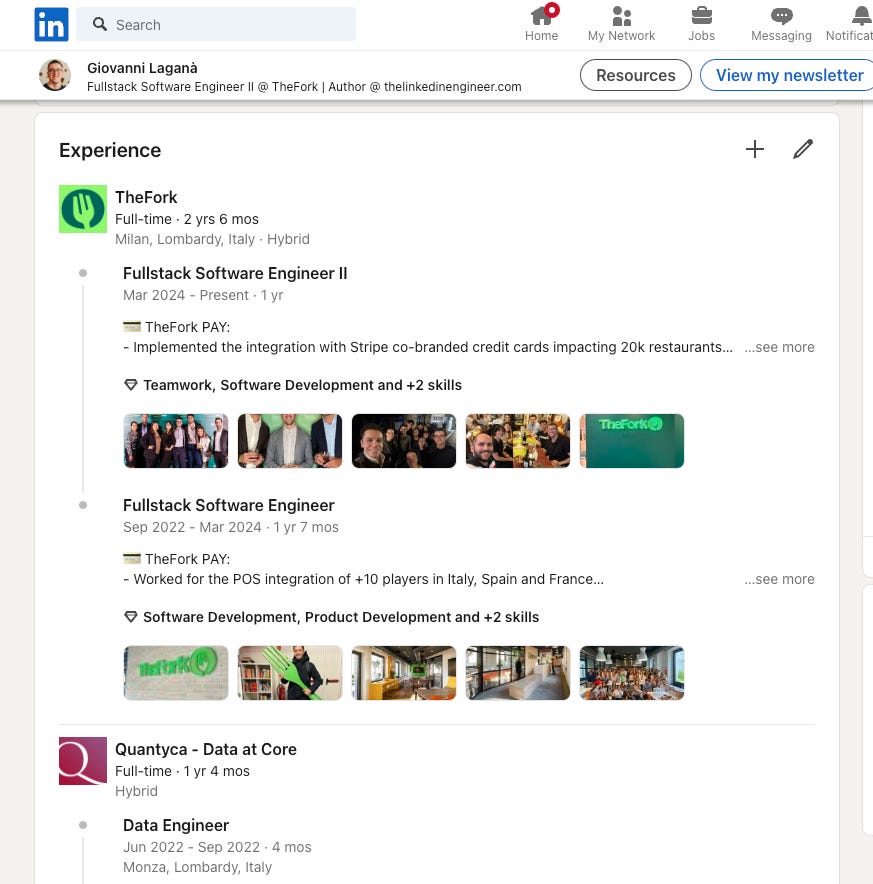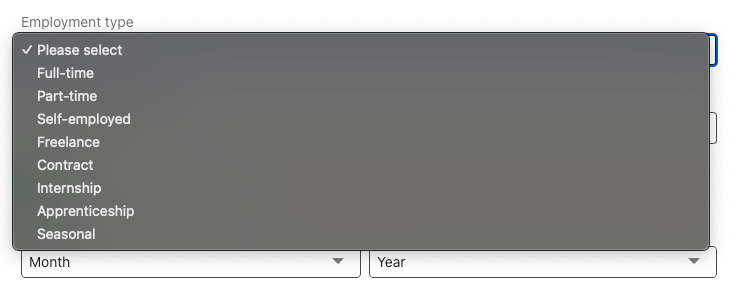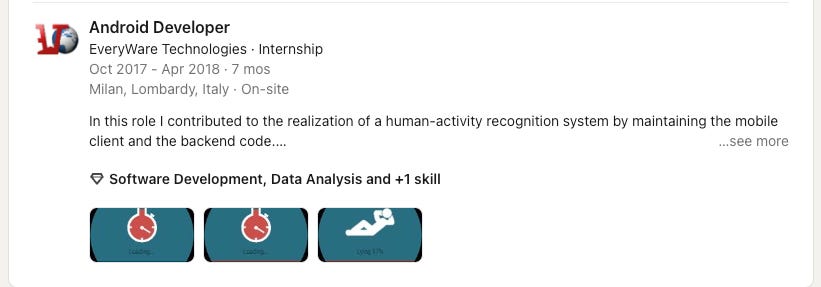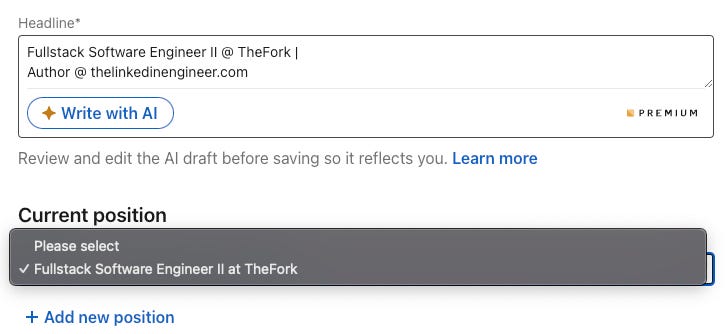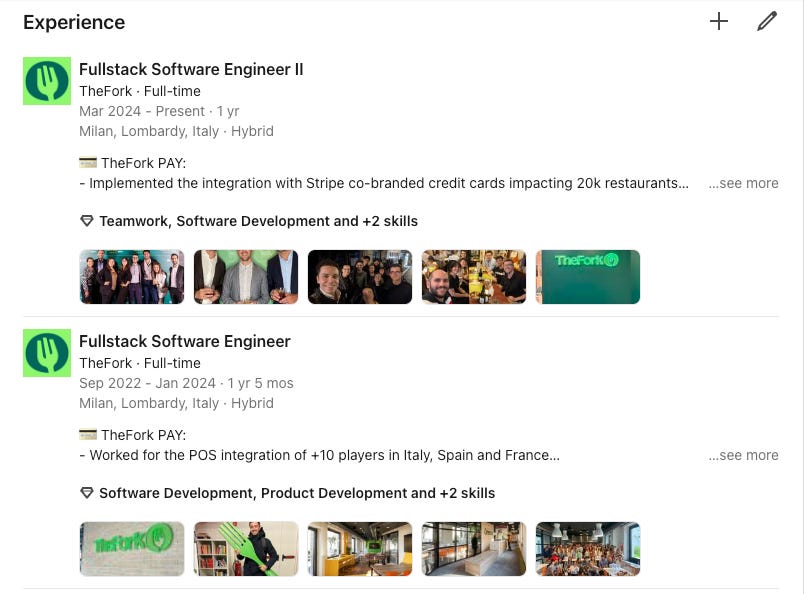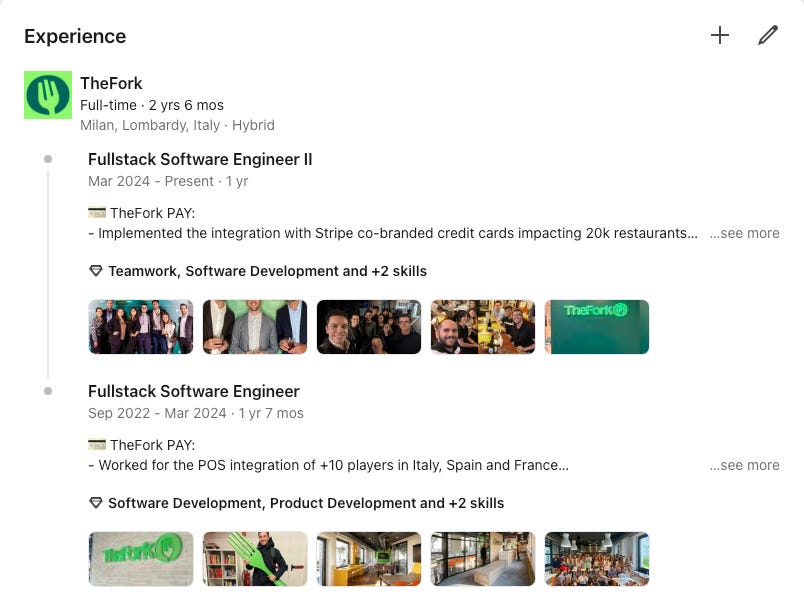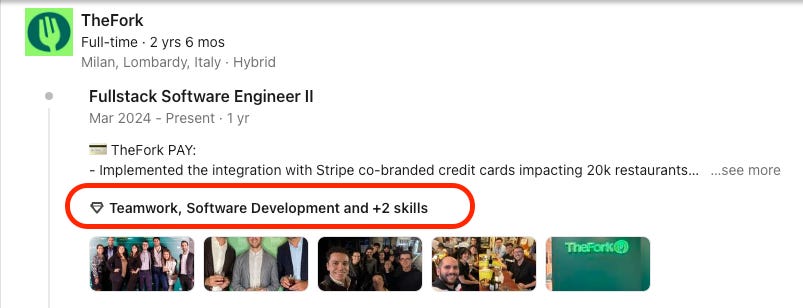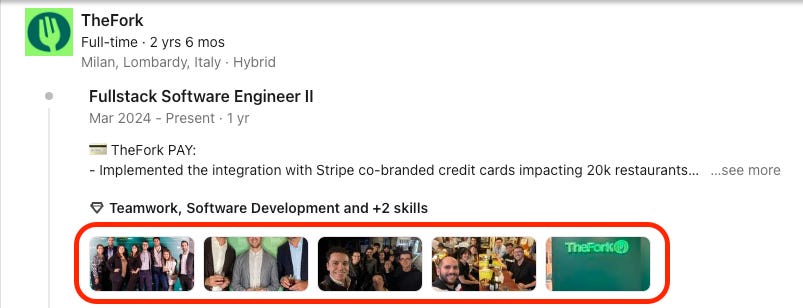The "Experience" section 💼
The most famous one
Ladies and gentlemen 🎙️, today we examine the most discussed section.
Probably the one where people lie the most.
For sure, the most important space of your profile, where all recruiters spend more time: the Experience section.
This is one of the first features that was developed on LinkedIn, and it represents the timeline of your journey in the professional world.
I have been on LinkedIn since 2020, and year by year, I have seen this section change many times, becoming more and more complex and including new types of information every time.
Also, think about it: this is the section that you are most likely to keep up to date as time passes and you change company or position.
“What if I don’t change role? 🤔”
👉🏻 In this article, I will also show you how important it is to keep this section updated even when you are not looking for another job.
With that being said, it’s not hard to understand why this is the section that definitely requires more time. But don’t worry, I am here to help you with that.
So fasten your seat belt,
And let’s jump into today’s article 👇🏻
📅 Timeline Composition
The timeline is a composition of positions, and at the time I am writing this post, this is the set of possible employment types you can choose from.
Depending on your amount of experience, you might face different difficulties finding things to write.
📚 If you are a Student
Clearly, at the beginning of your career you will struggle to write meaningful experiences.
Because of that, you will need to do your best to look in your path and find them.
People tend to underestimate things that they think are not relevant for their LinkedIn, but then they turn out to be absolutely suitable for this section.
Maybe you did a Hackathon, you joined the Mathematical Olympiad, or why not, maybe you did small jobs like delivering pizzas, working as a barman, or being a waiter.
Many people think this is not relevant because it doesn’t match their career, for example, as a Software Engineer.
The reality is that by putting such information, you showcase an important aspect of your personality: that you get busy for your aspirations, or just for finding money in a very responsible way (without asking your parents).
This kind of attitude is really appreciated and highly respected by people. As far as I am concerned, I was not able to study and work at the same time, but I have always admired such people (and honestly I don’t know how they find the energy to do both things).
💡 Bonus tip: consider also students collaborations where you can work as a tutor, join Open Days, be a student representative, or be part of any kind of University organization, etc.
Still, if you don’t have any of the experiences above, honestly, don’t feel bad about it. Leave it empty for the moment, and the time will come.
👩🏼🎓 If you are a Fresh Grad
Here, you no longer have excuses: if you graduated, you have for sure written your thesis during an internship.
The internship is typically internal (at the University) or external (in a Company).
Don’t make the mistake of thinking that an internal internship is not an experience: just consider the University as a Company you worked for, and the topic you worked on to determine the role you had during that experience.
For example:
during my Bachelor’s Degree, I worked for a University spin-off called EveryWare Technologies on a human-activity recognition application on Android
→ Experience: Android Developer - Internship
during my Master’s Degree, I worked on a thesis on fake news detection within University
→ Experience: Data Scientist - Internship
💼 If you are a Professional
In this case, what you have to pay attention is
if you change company
if you change role
👉🏻 If you change company, you need to make sure to create another item. The only thing to pay attention here is ensuring that your last present position is aligned with the headline.
As you can see, the current position is linked to the top of your profile to display the logo of your current company, however the Headline is a free text (and people ALWAYS forget to update it as soon as they change company 💀)
👉🏻 Instead, if you change role (within the same company), you need to pay attention to the time intervals.
If you leave a break of at least 2 months, LinkedIn considers the two positions as separate items, creating a confusing effect
Whereas, if you maintain a continuous sequence of positions (or a break of a maximum of 1 month), LinkedIn merges them into the same cluster, creating a sub-timeline
This representation is definitely preferable, as it’s clearer and, most importantly, gives an idea of the progression you had within that company.
✍🏻 How to write the job position
It doesn’t matter if you are a student or a professional, the golden rule is the same: enrich the item as much as possible.
Of course, the point is not to make it verbose but to have rich content.
How?
By fulfilling every possible subsection as follows
1️⃣ Title - Employment Type - Company - Time Interval - Location
Some of these fields are optional, but make sure to fill in all the information.
In particular, a special mention goes to the Title choice:
apart from what I wrote above for students, I generally recommend sticking to what’s written in your contract.
The only exception when it makes sense to choose a different role is this:
if the official role given is completely unrepresentative of what you do and could be an obstacle to your career growth. In that case, you can opt for a role chosen by you, but I would honestly recommend either agreeing on it within your company or making the change only when your professional collaboration with that company is over.
2️⃣ Description
The description should highlight the main milestones you achieved in that role:
let me give you some tips
Use bullet points: this will help you save space and list all the important points.
Be numeric-driven: try to link every contribution to a numeric result to provide a quantitative measure of your impact.
Company numbers are your numbers: if you work for an app with 50 million users, your work impacts 50 million users.
Always write in first person.
Use emojis to make the reading more engaging.
Don’t try to do everything at once: update it little by little and develop the habit of keeping this section updated!
My favourite one: you could easily forget things so write a brag document (don’t know what a brag document is? Read my LinkedIn post!)
3️⃣ Skills
Remember to include a set of skills related to that position
My advise is:
identify a few key skills
make sure they are coherent with the position
repeat them across all your positions
vary very few of them unless there’s something specific to that position
4️⃣ Media
Finally, don’t forget to attach some pictures!
We tend to forget that what we see on LinkedIn is… trusted?
Nobody prevents someone from lying and claiming they work at Google. Attaching pictures has three pros:
gives authenticity and proves you work there
shortens the distance even more with the reader if you include pictures of people (human empathy)
again, enriches content


